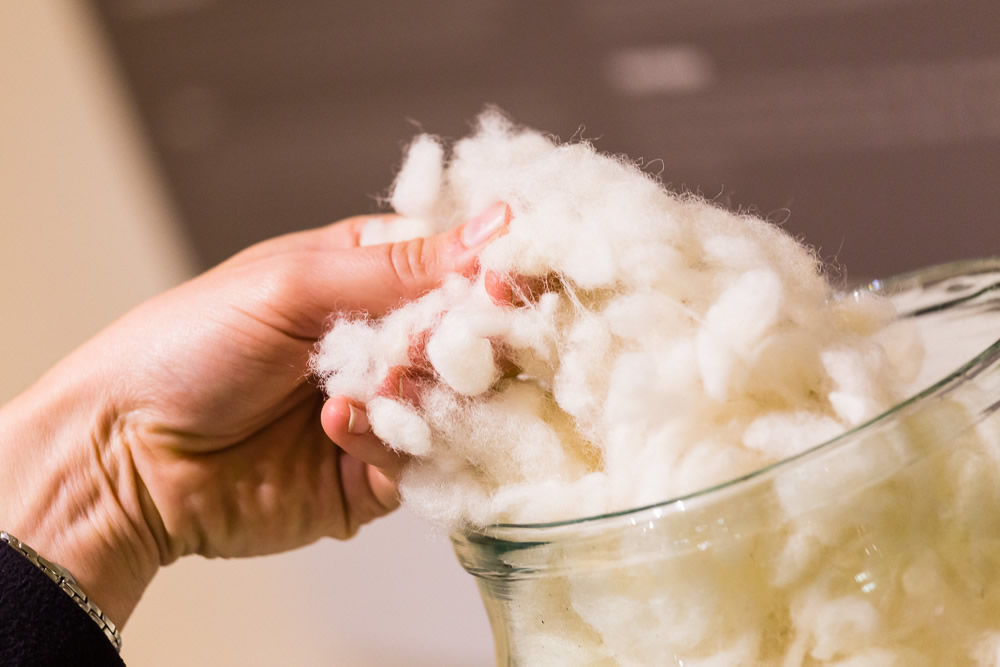About Wool

WHY WOOL?
NATURAL
Wool is a protein fibre formed in the skin of sheep, and is thus one hundred percent natural, not man-made. Since the Stone Age, it has been appreciated as one of the most effective forms of all-weather protection known to man, and science is yet to produce a fibre which matches its unique properties.
RENEWABLE
As long as there is grass to graze on, every year sheep will produce a new fleece; making wool a renewable fibre source. Woolgrowers actively work to safeguard the environment and improve efficiency, endeavouring to make the wool industry sustainable for future generations.
BIODEGRADABLE
At the end of its useful life, wool can be returned to the soil, where it decomposes, releasing valuable nutrients into the ground. When a natural wool fibre is disposed of in soil, it takes a very short time to break down, whereas most synthetics are extremely slow to degrade.
NATURAL INSULATOR
Wool is a hygroscopic fibre. As the humidity of the surrounding air rises and falls, the fibre absorbs and releases water vapour. Heat is generated and retained during the absorption phase, which makes wool a natural insulator. Used in the home, wool insulation helps to reduce energy costs and prevents the loss of energy to the external environment,
thus reducing carbon emissions.
BREATHABLE
Wool fibres are crimped, and when tightly packed together, form millions of tiny pockets of air. This unique structure allows it to absorb and release moisture—either in the atmosphere or perspiration from the wearer—without compromising its thermal efficiency. Wool has a large capacity to absorb moisture vapour (up to 30 per cent of its own weight) next to the skin, making it extremely breathable.
RESILIENT & ELASTIC
Wool fibres resist tearing and are able to be bent back on themselves over 20,000 times without breaking. Due to its crimped structure, wool is also naturally elastic, and so wool garments have the ability to stretch comfortably with the wearer, but are then able to return to their natural shape, making them resistant to wrinkling and sagging. Wool therefore maintains its appearance in the longer term, adding value to the product and its lifespan. Wool is also hydrophillic—it is highly absorbent, and retains liquids—and so dyes richly while remaining colourfast, without the use of chemicals.
MULTI-CLIMATIC/ TRANS-SEASONAL
Thanks to its hygroscopic abilities, wool constantly reacts to changes in body temperature, maintaining its wearer’s thermophysical comfort in both cold and warm weather.
EASY CARE
The protective waxy coating on wool fibres makes wool products resistant to staining and they also pick up less dust as wool is naturally anti-static. Recent innovations mean wool items are no longer hand-wash only. Many wool products can now be machine-washed and tumble dried.
ODOUR RESISTANT
Wool is far more efficient than other textiles at absorbing sweat and releasing it into the air, before bacteria has a chance to develop and produce unpleasant body odour.
A SAFE SOLUTION
Wool is naturally safe. It is not known to cause allergies and does not promote the growth of bacteria. It can even reduce floating dust in the atmosphere, as the fibre’s microscopic scales are able to trap and hold dust in the top layers until vacuumed away. Thanks to its high water and nitrogen content, wool is naturally flame-retardant, and has a far higher ignition threshold than many other fibres, will not melt and stick to the skin causing burns, and produces less noxious fumes that cause death in fire situations. Finally, wool also has a naturally high level of UV protection, which is much higher than most synthetics and cotton.
Please download here theIWTO Sheep Welfare Guidelines_2013 for wool sheep welfare, a concise summation of good practice principles for ethical wool sheep production




